EPISODE 8: ASHEVILLE TO GEORGIA
Situated midway down the Blue Ridge Parkway is the town of Asheville, NC. The main attraction there is the Biltmore Estate built by George Vanderbilt, grandson of railroad tycoon and probable robber baron, Cornelius Vanderbilt. I have not been negative about much of anything on this trip but I am going to be a little bit negative here because I just did not like it very much. When I first saw it I thought I was in the Loire Valley -- this structure would fit in there but not here.
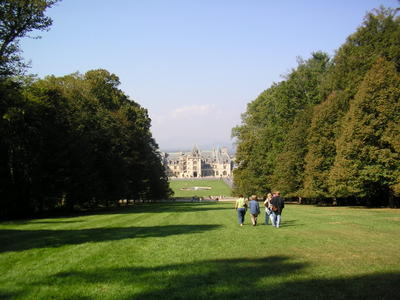
Biltomore view
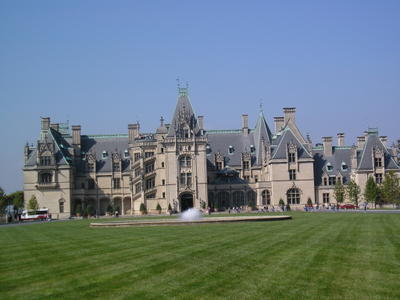
Big house
Old George tried to use good taste by hiring famous architect Richard Morris Hunt and filling it with famous art. Hunt did a great job building a French renaissance house, but why? I just don’t think it fits into the Blue Ridge Mountains of North Carolina. Compare Fallingwater, how it fits into its location. Also, somehow I like San Simeon more – I am sure William Randolph Hearst’s taste was more suspect but somehow his effort seems more honest in its acquisitive grossness.
Also, at Biltmore I found it hard to believe that anyone could have so much money. It reminded me of when I was at Chatsworth House in England a year or so ago (the family the Kennedy sister who was later killed in an airplane crash married into); I asked one of the attendants what all the stuff inside the house meant; did it mean that the person who has the most stuff when he dies wins?
On the self-guided house tour as I entered the library another visitor asked a staff person if she had heard all the possible questions. I said I had one she may not have heard. Having just left the billiard room, I asked her if she knew where Col. Mustard was. And I had not even been to the conservatory yet.
One very positive thing that Vanderbilt did was hire Fredrick Law Olmstead to design the grounds and they are very impressive. According to The Devil in the White City, Olmstead spent a lot of time here in Ashville when Daniel Burnham wished he were in Chicago working on the Columbia Exhibition.
Olmstead, in turn, suggested hiring Gifford Pinchot to run the forestry program. This was a new field in America. Pinchot went on to be the first director of the US Forestry Service. They then brought in a German to run the program at Biltmore. It is interesting that Pinchot was educated in France and then a German was brought in to establish the first forestry school on the Biltmore property. This is all recounted in the Forest Service’s Cradle of Forestry interpretive center north of Asheville and about 4 miles off the parkway.
Back to the grounds at Biltmore. As would be expected, to me Olmstead’s less formal gardens are more impressive than the formal gardens. Here is a view of the house from the Shrub Garden:

From the Shrub Garden
The formal English style Walled Garden, as seen is this picture, was nice but I have seen better in England. (Also, his “Italian Garden” – not pictured – was nothing really special and it was more French anyway.)
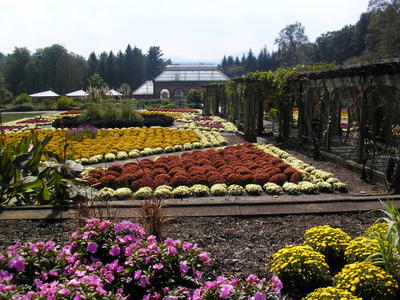
Walled Garden
Actually, the part of the Walled Garden I liked the best was the butterfly garden that actually had butterflies hovering around the plants. In the picture below there is actually a yellow butterfly hanging from the stem of yellow flowers.
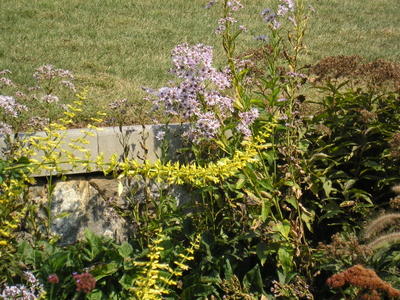
Butterfly Garden
The other main Asheville attraction, although very, very different, is the Thomas Wolfe memorial that consists of a visitor center and the restored former boarding house run by his mother that was portrayed as “Dixieland” in Look Homeward Angel. I have never read him so I did not know how autobiographical his novels were, a fact that was not appreciated (at first) by Asheville residents who recognized themselves and considered their portrayal unfavorable. Here is Old Kentucky Home, the boarding house:
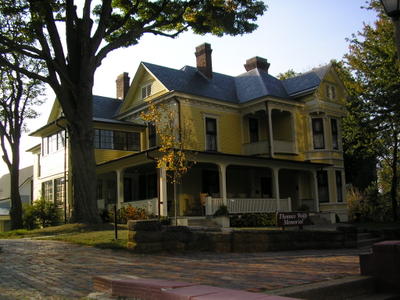
You can't go home again
Downtown they have a couple of memorials too. First, there is a little marker on the spot where Tom’s dad had his stone monument shop. Supposedly that is where the stone angel stood that was looking home. This marker contains stone cutting tools with a quote from one of Tom’s novels. In the background of this picture is a sculpture that was done by the late husband of a woman I met when I parked my car and asked her where the statue of the angel was. That stature is shown in the next picture.
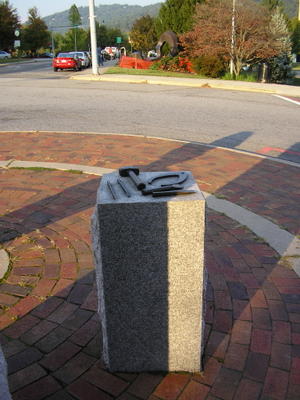
Tom's dad's tools
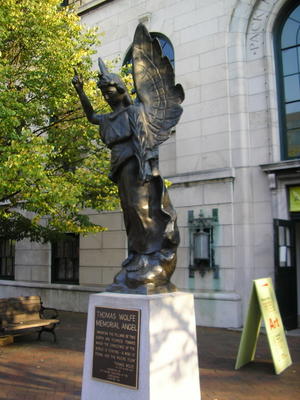
Looking homeward
After Asheville I returned to the Blue Ridge Parkway. Overall I traveled from about Mile 105 near Roanoke to the end at mile 469, which makes 364 miles over parts of four days. I did not realize that October is the most popular month because of fall colors. They were impressive but I saw more color farther north in NY and Pennsylvania. I mentioned before the old time feeling with the stone decorated tunnels and some stone barriers along the edge of the road. I loved the tunnels especially, most of which curve as they bend around and through the mountains. Another thing that impressed me is how one feels completely removed from the urban environment; however, there is a lot of development deceptively close to portions of the parkway but you would not know this unless you left the parkway. Here are some pictures from along what is one of the most scenic drives in America.
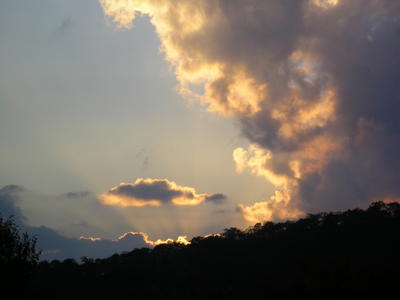
Sunset on the Blue Ridge Parkway
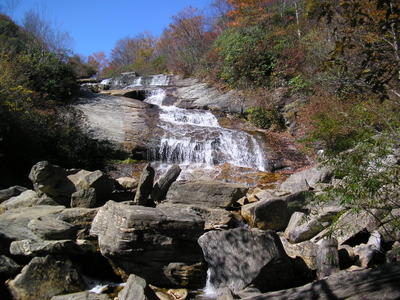
Lower Falls
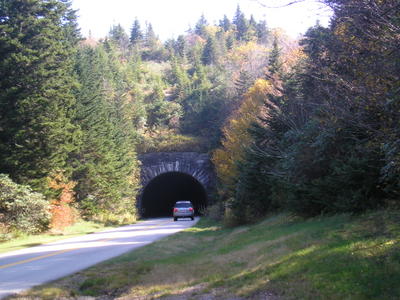
Tunnel on Blue Ridge Parkway
At the end of the parkway your can either turn right and visit the Great Smoky Mountains or turn left and visit the incredible town of Cherokee, the capitol of the Cherokee reservation. This is all that is left of the Cherokee nation that was mostly moved to Oklahoma in the Trail of Tears. It has all sorts of crap as well as some museums that I suppose might be nice. But I mainly went here because I was hungry. As it turned out my lunch was a treat because of a waitress at the Grandma’s Pancake and Steak restaurant. She looked like she could be a Native American but her accent was not right. (An Indian waiter had a really strong southern accent.) I asked her where she was from and she said Indonesia. I then started talking to her in Indonesian. She was surprised and we had a nice limited conversation. I think she was on some sort of training program but I am not too sure since my Indonesian is not all that good anymore, although people in the restaurant were impressed.
The Great Smoky Mountains are very touristy. It is the most visited of all National Parks. And, as I said, October is the most popular month. I decided not to spend much time here after driving through in a long line of traffic. At the other side of the park is the town of Gatlinburg. I wanted to see it because that is where Johnny Cash’s Boy Named Sue met his father. But as soon as you leave the national park you hit a horrid street full of Day’s Inns, KFCs, etc., etc. Sort of a bookend upscale cohort to Cherokee on the other side of the park. Maybe there is a nice older downtown Gatlinburg somewhere, and maybe there is a street of mud with a bar on it as in the song, but I won’t see those since I did a “180 “and headed back into the park. I also took the advice of a park ranger to avoid traffic by not driving past Dollywood which is a little down the road from Gatlinburg. I kind of wanted to at least see where Dolly Parton’s theme park was located but I figured there were twin peaks back in the park.
After driving around the park through Tennessee I headed back to North Carolina on small winding roads. Off the beaten track down near the Georgia border, but still in North Carolina, is a highway lined with waterfalls. The largest is called Dry Falls for some reason. They are hardly dry as can be seen in these pictures.
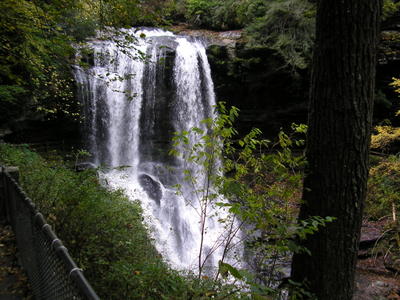
Dry? Falls
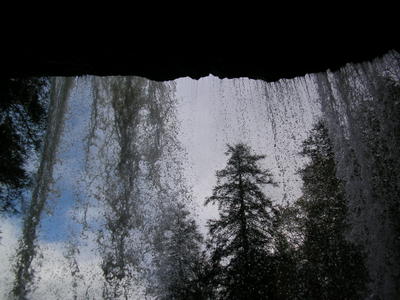
Looking out from under the falls
Just over the border into Georgia is the famous Dillard House restaurant. It is a huge place and the amount of food they serve is extraordinary and it is all you can eat. The quality (as well as the quantity) was surprisingly good. When you sit down there are starters already on the table: cole slaw, apple salad, relishes, and calico salad, which is a delicious combination of tomatoes, cucumbers, etc. Then they bring ice tea. sweat or unsweetened, and a basket of biscuits and corn bread. Next comes the meal: individual plates of each item and you can have more of anything you like, just like grandma’s house. This meal consisted of two kinds of chicken (friend and roasted – OK, not great), spare ribs (no sauce but very smoky and very delicious), country steak in mushroom gravy (really good), country ham (also OK, not great), green beans (overcooked of course), collard greens, fried potatoes with onions, sweat potato soufflé (really good), creamed corn (not good), cheesy creamed cauliflower (surprisingly good), fried green tomatoes, and strawberry cobbler with ice cream for dessert. As I was eating I realized I had no idea how much it cost but it was only $22.50. As I said, it was all you could eat and I took home most of the chicken and half of the ham but ordered a couple more spare ribs since they were so tasty. But the actual highlight for me was the fried green tomatoes, which I never had before. They were terrific. Now that I am in the South there should be more of those on the way.
After that meal I don’t know how I could think of food but I had to check out the other possible largest apple in the world. This was actually a gift from the city of Winchester, VA (see Episode 5) to the city of Cornelia, Georgia. I am not sure which is bigger, but this one looks pretty large.
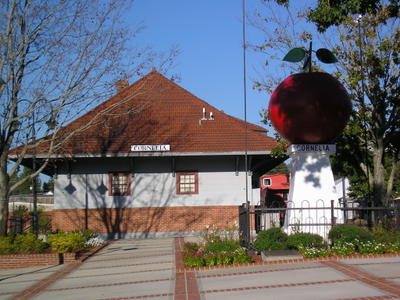
Another Big Apple

2 Comments:
I would be very happy to live in that mansion!! Your photographs are amazing. I am so jealous, would love to get in a car and spend a good few months driving around the US
3:30 PM
I would be very happy to live in that mansion!! Your photographs are amazing. I am so jealous, would love to get in a car and spend a good few months driving around the US
3:30 PM
Post a Comment
<< Home